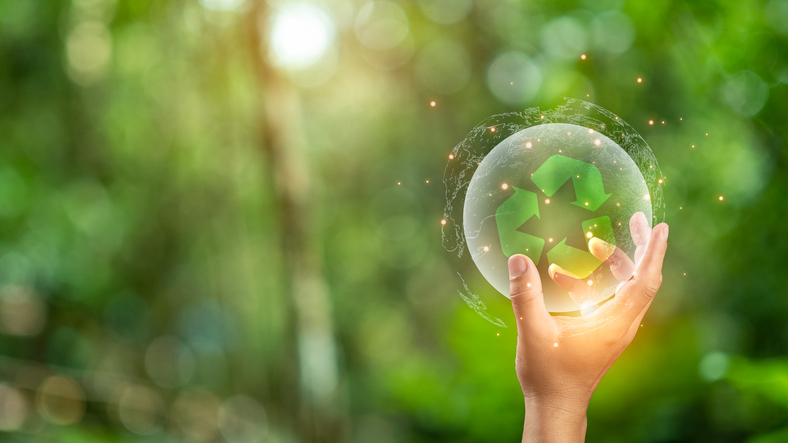Learn How to Improve Your Carbon Footprint and Appeal to Eco-Conscious Consumers
Plastic packaging plays a vital role in protecting products, preserving freshness, and ensuring safe delivery to consumers. But with global plastic waste topping 400 million metric tons annually, and packaging materials making up a significant portion of U.S. landfill waste, many businesses are rethinking their impact. As sustainability becomes a higher priority for consumers, brands have an opportunity to lead the way be exploring sustainable packaging options.
With growing concerns about pollution, legislation, and environmental impact, the pressure to find sustainable packaging options is stronger than ever.
Fortunately, the shift to sustainable packaging is both possible and profitable. Consumers are increasingly demanding eco-friendly solutions. 82% are willing to pay more for products with sustainable packaging. In fact, products with ESG-related labels saw 28% growth over five years. Products without these statements only grew by 20%.
Now is the time to explore smarter packaging strategies that align with evolving consumer expectations and environmental mandates. In this blog, we’re breaking down three concepts you need to understand. Post-consumer recyclable packaging (PCR), the How2Recycle program (H2R), and extended producer responsibility (EPR). That way, you can make informed decisions and stay ahead in the sustainable packaging movement.
PCR Packaging
Post-consumer recycled (PCR) content is made from the items that consumers recycle every day. This might include aluminum, cardboard boxes, paper, plastic bottles, and more.
Materials are collected by local recycling programs, then shipped to recycling facilities. There, they are sorted into bales based on the material. The bales are then melted or ground into small pellets and molded into new items.
PCR allows brands to fulfill their sustainability goals without relying on the consumer to recycle or compost the packaging after use. This encourages a closed-loop system where plastic is reused and recycled instead of being disposed of in landfills. Additionally, PCR plastic generally uses less energy and releases fewer emissions than producing virgin plastic.
Want to explore PCR options from PPC Flex? Learn more here.
H2R Program
How2Recycle is a standardized labeling system that clearly communicates disposal instructions to consumers. It began in 2008 as a project of the Sustainable Packaging Coalition. In 2012, it finished its soft launch with 12 pilot companies.
The goals of the H2R program are simple:
- Create a clear, well-understood, and nationally harmonized label that enables companies to convey to consumers how to dispose of a package.
- Improve the reliability, completeness, and transparency of recyclability claims.
- Provide a labeling system that is designed to follow legislation and guidance in the United States and Canada.
- Increase the availability and quality of recycled material.
Signing up for the H2R program is easy and could have major benefits for your brand. In fact, 84% of consumers are more likely to buy a product that includes a How2Recycle label. Companies must become members, pay an annual fee, and sign a membership agreement to become part of the program. Brands and retailers who are already members of the Sustainable Packaging Coalition receive a discounted membership. Material manufacturers and converters can also become members.
Once you’ve enrolled in the program, you simply have to submit your packaging to the H2R program. From there, they will designate which label should be on your packaging. Once your packaging is in consumers’ hands, you can reference the member platform to analyze the overall recyclability of your packaging. You can also find information that will help you continue to improve your packaging.
If you’d rather not go through all these steps, you can simply partner with PPC Flex for your packaging materials. We can create packaging that’s certified to certain aspects of the How2Recycle program. In fact, our Thrive line of products offers all the benefits of traditional packaging with the added benefits of the H2R program.
EPR for Packaging
The concept and implementation of extended producer responsibility (EPR) is not new. The paint, battery, and pharmaceutical industries have been impacted by this idea over the past few decades. Now, it’s making its way into the packaging industry.
Much of the packaging EPR laws target plastic and single-use plastics. It intends to shift responsibility away from the consumer/taxpayer and toward the producer (brand/importer/distributor). The goal is to encourage producers to design packaging with waste reduction and sustainability in mind to help advance the United States toward a truly circular economy. At the time of writing, 12 states have introduced legislation on EPR for packaging. Five EPR for packaging bills have been passed in the United States.
Most programs encourage or require producers of packaging products to join a collective Producer Responsibility Organization (PRO), though some allow producers to comply individually. With most EPR programs, the producers will pay fees to the PRO. The PRO then distributes the funds to cover the costs required by the program legislation. Part of those costs will typically provide funding for the end-of-life infrastructure (collection, sorting, processing) of covered products.

Source: Sustainable Packaging Coalition
Producers do not need to be headquartered in a regulated state to be subject to the state’s EPR regulations. If they’re selling into the state, they will likely be obligated.
Complying with these new regulations is easy with PPC Flex by your side. Learn more in our in-depth blog.
Overwhelmed by Changing Packaging Rules and Regulations? We Can Help
Navigating the ever-evolving world of sustainable packaging options can feel overwhelming. But, it doesn’t have to be. Whether you’re exploring PCR materials, seeking guidance on How2Recycle labeling, or preparing for EPR compliance, PPC Flex is here to help. Our team is well-versed in the latest packaging innovations and regulations. We’re committed to helping you reduce your environmental impact while meeting consumer expectations.
Let us take the guesswork out of going green. Partner with us to build a smarter, more sustainable packaging strategy. Contact us today.
